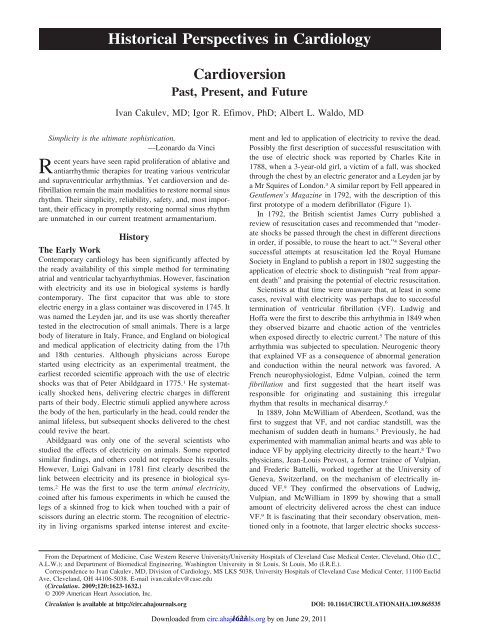Cardioversion Past, Present, and Future - the Laboratory of Igor Efimov
Cardioversion Past, Present, and Future - the Laboratory of Igor Efimov
Cardioversion Past, Present, and Future - the Laboratory of Igor Efimov
Create successful ePaper yourself
Turn your PDF publications into a flip-book with our unique Google optimized e-Paper software.
Historical Perspectives in Cardiology<strong>Cardioversion</strong><strong>Past</strong>, <strong>Present</strong>, <strong>and</strong> <strong>Future</strong>Ivan Cakulev, MD; <strong>Igor</strong> R. <strong>Efimov</strong>, PhD; Albert L. Waldo, MDSimplicity is <strong>the</strong> ultimate sophistication.—Leonardo da VinciRecent years have seen rapid proliferation <strong>of</strong> ablative <strong>and</strong>antiarrhythmic <strong>the</strong>rapies for treating various ventricular<strong>and</strong> supraventricular arrhythmias. Yet cardioversion <strong>and</strong> defibrillationremain <strong>the</strong> main modalities to restore normal sinusrhythm. Their simplicity, reliability, safety, <strong>and</strong>, most important,<strong>the</strong>ir efficacy in promptly restoring normal sinus rhythmare unmatched in our current treatment armamentarium.HistoryThe Early WorkContemporary cardiology has been significantly affected by<strong>the</strong> ready availability <strong>of</strong> this simple method for terminatingatrial <strong>and</strong> ventricular tachyarrhythmias. However, fascinationwith electricity <strong>and</strong> its use in biological systems is hardlycontemporary. The first capacitor that was able to storeelectric energy in a glass container was discovered in 1745. Itwas named <strong>the</strong> Leyden jar, <strong>and</strong> its use was shortly <strong>the</strong>reaftertested in <strong>the</strong> electrocution <strong>of</strong> small animals. There is a largebody <strong>of</strong> literature in Italy, France, <strong>and</strong> Engl<strong>and</strong> on biological<strong>and</strong> medical application <strong>of</strong> electricity dating from <strong>the</strong> 17th<strong>and</strong> 18th centuries. Although physicians across Europestarted using electricity as an experimental treatment, <strong>the</strong>earliest recorded scientific approach with <strong>the</strong> use <strong>of</strong> electricshocks was that <strong>of</strong> Peter Abildgaard in 1775. 1 He systematicallyshocked hens, delivering electric charges in differentparts <strong>of</strong> <strong>the</strong>ir body. Electric stimuli applied anywhere across<strong>the</strong> body <strong>of</strong> <strong>the</strong> hen, particularly in <strong>the</strong> head, could render <strong>the</strong>animal lifeless, but subsequent shocks delivered to <strong>the</strong> chestcould revive <strong>the</strong> heart.Abildgaard was only one <strong>of</strong> <strong>the</strong> several scientists whostudied <strong>the</strong> effects <strong>of</strong> electricity on animals. Some reportedsimilar findings, <strong>and</strong> o<strong>the</strong>rs could not reproduce his results.However, Luigi Galvani in 1781 first clearly described <strong>the</strong>link between electricity <strong>and</strong> its presence in biological systems.2 He was <strong>the</strong> first to use <strong>the</strong> term animal electricity,coined after his famous experiments in which he caused <strong>the</strong>legs <strong>of</strong> a skinned frog to kick when touched with a pair <strong>of</strong>scissors during an electric storm. The recognition <strong>of</strong> electricityin living organisms sparked intense interest <strong>and</strong> excitement<strong>and</strong> led to application <strong>of</strong> electricity to revive <strong>the</strong> dead.Possibly <strong>the</strong> first description <strong>of</strong> successful resuscitation with<strong>the</strong> use <strong>of</strong> electric shock was reported by Charles Kite in1788, when a 3-year-old girl, a victim <strong>of</strong> a fall, was shockedthrough <strong>the</strong> chest by an electric generator <strong>and</strong> a Leyden jar bya Mr Squires <strong>of</strong> London. 3 A similar report by Fell appeared inGentlemen’s Magazine in 1792, with <strong>the</strong> description <strong>of</strong> thisfirst prototype <strong>of</strong> a modern defibrillator (Figure 1).In 1792, <strong>the</strong> British scientist James Curry published areview <strong>of</strong> resuscitation cases <strong>and</strong> recommended that “moderateshocks be passed through <strong>the</strong> chest in different directionsin order, if possible, to rouse <strong>the</strong> heart to act.” 4 Several o<strong>the</strong>rsuccessful attempts at resuscitation led <strong>the</strong> Royal HumaneSociety in Engl<strong>and</strong> to publish a report in 1802 suggesting <strong>the</strong>application <strong>of</strong> electric shock to distinguish “real from apparentdeath” <strong>and</strong> praising <strong>the</strong> potential <strong>of</strong> electric resuscitation.Scientists at that time were unaware that, at least in somecases, revival with electricity was perhaps due to successfultermination <strong>of</strong> ventricular fibrillation (VF). Ludwig <strong>and</strong>H<strong>of</strong>fa were <strong>the</strong> first to describe this arrhythmia in 1849 when<strong>the</strong>y observed bizarre <strong>and</strong> chaotic action <strong>of</strong> <strong>the</strong> ventricleswhen exposed directly to electric current. 5 The nature <strong>of</strong> thisarrhythmia was subjected to speculation. Neurogenic <strong>the</strong>orythat explained VF as a consequence <strong>of</strong> abnormal generation<strong>and</strong> conduction within <strong>the</strong> neural network was favored. AFrench neurophysiologist, Edme Vulpian, coined <strong>the</strong> termfibrillation <strong>and</strong> first suggested that <strong>the</strong> heart itself wasresponsible for originating <strong>and</strong> sustaining this irregularrhythm that results in mechanical disarray. 6In 1889, John McWilliam <strong>of</strong> Aberdeen, Scotl<strong>and</strong>, was <strong>the</strong>first to suggest that VF, <strong>and</strong> not cardiac st<strong>and</strong>still, was <strong>the</strong>mechanism <strong>of</strong> sudden death in humans. 7 Previously, he hadexperimented with mammalian animal hearts <strong>and</strong> was able toinduce VF by applying electricity directly to <strong>the</strong> heart. 8 Twophysicians, Jean-Louis Prevost, a former trainee <strong>of</strong> Vulpian,<strong>and</strong> Frederic Battelli, worked toge<strong>the</strong>r at <strong>the</strong> University <strong>of</strong>Geneva, Switzerl<strong>and</strong>, on <strong>the</strong> mechanism <strong>of</strong> electrically inducedVF. 9 They confirmed <strong>the</strong> observations <strong>of</strong> Ludwig,Vulpian, <strong>and</strong> McWilliam in 1899 by showing that a smallamount <strong>of</strong> electricity delivered across <strong>the</strong> chest can induceVF. 9 It is fascinating that <strong>the</strong>ir secondary observation, mentionedonly in a footnote, that larger electric shocks success-From <strong>the</strong> Department <strong>of</strong> Medicine, Case Western Reserve University/University Hospitals <strong>of</strong> Clevel<strong>and</strong> Case Medical Center, Clevel<strong>and</strong>, Ohio (I.C.,A.L.W.); <strong>and</strong> Department <strong>of</strong> Biomedical Engineering, Washington University in St Louis, St Louis, Mo (I.R.E.).Correspondence to Ivan Cakulev, MD, Division <strong>of</strong> Cardiology, MS LKS 5038, University Hospitals <strong>of</strong> Clevel<strong>and</strong> Case Medical Center, 11100 EuclidAve, Clevel<strong>and</strong>, OH 44106-5038. E-mail ivan.cakulev@case.edu(Circulation. 2009;120:1623-1632.)© 2009 American Heart Association, Inc.Circulation is available at http://circ.ahajournals.orgDOI: 10.1161/CIRCULATIONAHA.109.865535Downloaded from circ.ahajournals.org 1623 by on June 29, 2011



